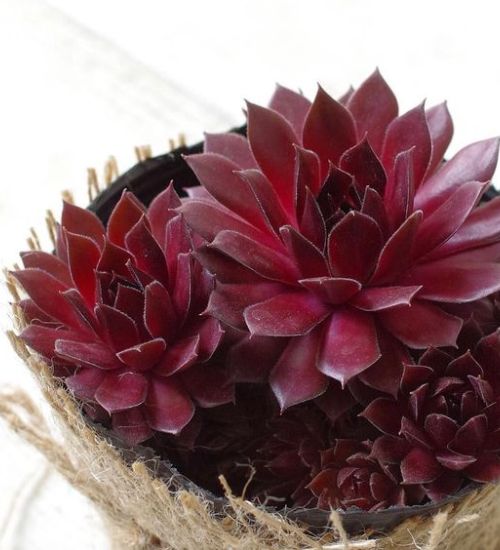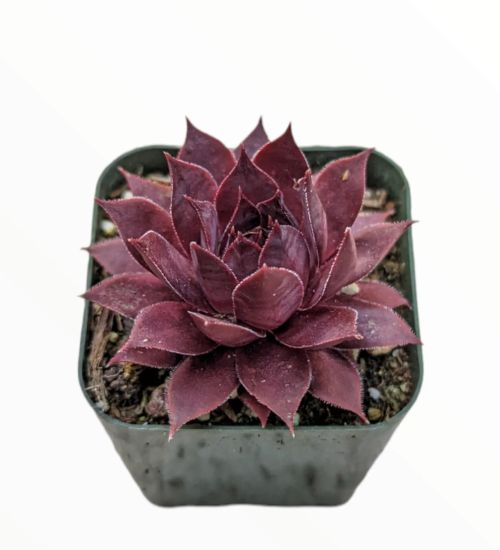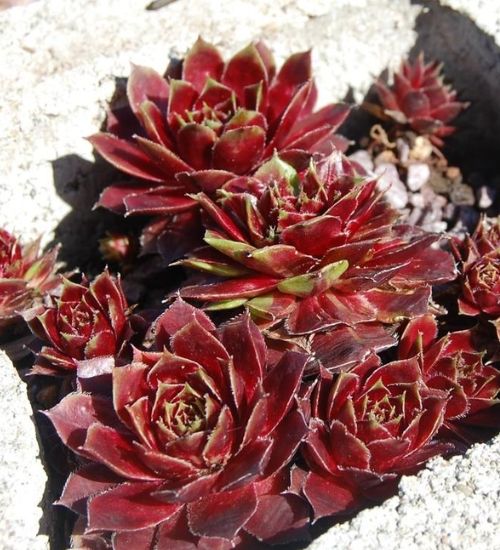Sun: full sun to partial shade
Water: Typical water needs for a succulent
Temperature: Zone 4a from -4°30F to -25° F (-34.4 ° C to -31.7° C) to Zone 6a from -10° F to -5° F (-23.3 ° C to -20.6° C)
Winter Survival: Cold hardy
Propagation: offsets
Flower: in the late summer and early fall
Flower Type: Showy
Toxic: Generally non-toxic to humans but can be toxic to animals.
Dormant: winter
Space Requirement: Indoors & Outdoors
Common Problems: Plants may rot if overwatered, pests
Where to buy Sempervivum Red Lion?
Basc Care for Sempervivum Red Lion
Watering
Regular watering period should be every 2 weeks
You can water your succulent more than often in extreme conditions but make sure that the soil is completely dry before watering your succulent again.
Fertilizing
Only feed this succulent during its active growing seasons which means winter. Use the right fertilizer applied in the right amounts. Applying half-strength balanced fertilizer every month or so is recommended for optimal results.
Do not fertilize during winter as the plant is dormant.
Sun & Location Requirements for "Sempervivum Red Lion"
Sempervivum Red Lion needs full sun to partial shade in order to thrive. While this variety needs plenty of bright light, it is important not to place it in direct sunlight for extended periods of time as this can cause damage or scorching to the leaves and stems. A shadier spot with indirect light could be just what Sempervivum Red Lion needs.
As per this succulent profile, it is only able to stay healthy when the environment temperature is above the range of zone 4a from -4°30F to -25° F (-34.4 ° C to -31.7° C).
Sempervivum Red Lion is a member of the Sempervivum family and is known for being cold hardy. It is able to survive temperatures down to 0°F, making it an ideal choice for areas with cold winters. The succulent's thick leaves and stems help retain moisture in its cells, allowing it to survive through frigid temperatures. Additionally, the colorful foliage of Sempervivum Red Lion adds a festive touch to any garden in cold areas.
Any succulents in the group will need a medium space to grow. You can place your pot at your table or window. Since this plant needs more space than mini succulents, you should consider do not plant them together with other succulents/plants.
Sempervivum Red Lion also benefits from some indirect light throughout the day as well, so make sure you give it enough space to soak up light without becoming too exposed to heat.
Propagation
Propagating with offsets is a great way to get more plants from the same mother plant. All you have to do is cut away an offset and pot it in soil, and soon enough you’ll have a brand-new Sempervivum Red Lion!
Toxicity

Although Sempervivum Red Lion is generally not toxic to humans, the saponins found in its leaves can be dangerous for animals if ingested. For this reason, it’s best to keep pets away from these plants and make sure they are out of reach.
Pests and Diseases
Sempervivum Red Lion can be affected common pests and diseases like most of the other succulents such as mealybugs.
If you do spot any of pest signs, you can treat your succulent using below methods.
- Mealybugs: quarantine, clean infected plants, soapy water.
Besides that, to prevent serious health issues from happening, keep your succulent in a well-ventilated area and check it regularly for any signs of pests or health problems.


